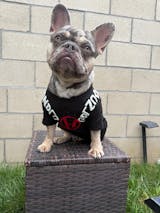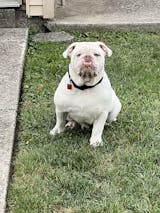Hypothermia in Dogs: Symptoms & Prevention
As winter's icy embrace settles in, our canine companions face a new set of challenges that go beyond just frolicking in the snow. Dog hypothermia, a chilling concern for pet owners, can sneak up on our furry friends and pose serious health risks. Understanding this condition is essential, as is the knowledge of how to recognize and combat its symptoms. In this blog post, we embark on a journey through the frosty landscapes of canine well-being, discovering what dog hypothermia entails, the telltale signs to watch out for, and most importantly, how to keep our four-legged pals warm, happy, and safe during the winter wonderland.

What is Dog Hypothermia?
Dog hypothermia occurs when a dog's body temperature drops below the normal range, typically between 101°F and 102.5°F (38.3°C - 39.2°C). This condition arises when a dog loses more heat than their body can generate, often due to prolonged exposure to cold weather, wet conditions, or icy waters. Dogs are susceptible to hypothermia just like humans, and certain breeds, especially those with short coats or smaller body sizes, may be more vulnerable. As their body temperature decreases, various physiological functions are affected, leading to symptoms ranging from shivering and lethargy to, in severe cases, loss of consciousness. It's crucial for dog owners to recognize the signs of hypothermia and take prompt measures to warm their furry companions to prevent more serious complications.
Symptoms of Dog Hypothermia:
Being aware of the symptoms of hypothermia in dogs is crucial because it allows for early detection and prompt intervention, preventing the condition from escalating to more severe stages. Early recognition enables pet owners to provide immediate warmth and care, potentially saving their furry friend from serious health complications.
Watch out for these warning signs that your pup might be feeling the chill:
- Shivering
- Weakness
- Slowed heart rate
- Difficulty breathing
- Stiff muscles
- Dilated Pupils
- Whining
- Drowsiness or lethargy
- Frostbite on extremities
Different Types of Hypothermia in Dogs:
- Mild Hypothermia (98°F - 100°F or 36.7°C - 37.8°C): Shivering and discomfort are common, but with prompt intervention, it's reversible.
- Moderate Hypothermia (90°F - 98°F or 32.2°C - 36.7°C): Shivering intensifies, and your pup may exhibit signs of depression or confusion. Immediate action is crucial.
- Severe Hypothermia (Below 90°F or 32.2°C): At this stage, your furry friend may lose consciousness, and their vital signs may become extremely weak. Emergency care is needed at this stage of hypothermia.
How to Thaw Out Your Chilly Canine:
- Wrap your dog in warm blankets: Provide immediate insulation by wrapping your dog in layers of warm blankets to trap their body heat and counteract the effects of hypothermia.
- Use a hot water bottle wrapped in a towel against their abdomen: Apply gentle warmth to your dog's core by placing a hot water bottle, carefully wrapped in a towel, against their abdomen. This helps restore their internal temperature.
- Heat blankets in the dryer: Warm up your pup by covering them with blankets that have been warmed in the dryer. This method offers a cozy and quick solution to elevate their body temperature.
- Monitor their temperature frequently: Keep a close eye on your dog's temperature during the warming process. Regular temperature checks will help you gauge the effectiveness of your efforts and ensure that they are on the path to recovery.
Preventing Dog Hypothermia:
Now, let's talk prevention! Here are some tail-wagging tips to keep your dog cozy and content:
- Layer Up: Invest in a snug-fitting doggy sweater or jacket for outdoor adventures.
- Dry and Toasty: After wet walks, make sure to dry your pup thoroughly, especially their paws and underbelly.
- Cozy Bedding: Provide warmth and insulated bedding in their favorite spot, away from cold drafts.
- Indoor Play: On chilly days, engage in indoor activities to keep them active without exposing them to harsh weather.
- Limit Exposure: Be mindful of the time your dog spends outdoors in cold weather, especially in freezing temperatures or windy conditions.
- Hearty Meals: Feed your dog a bit more during the colder months to generate extra body heat.

Grooming in the Wintertime:
Grooming is an essential part of dog care throughout any season! That’s where Squishface products come to play. Squishface has a line of dog skincare products, with formulations crafted specifically to cater to all dog breeds. Squishface Wrinkle Wipes can be used on dog’s tear stains, wrinkles, tail pockets, and even in-between their toes. They’re very convenient and are an effective way to clean your pup in-between baths. You can then go in with either Wrinkle Paste (designed for short-haired breeds) or Tear Stain Paste (designed for long-haired breeds), massaging a pea sized amount into your dog’s skin. Both pastes contain essential and limited ingredients that work to form a water-repellent barrier all while soothing your dog’s skin. Last but not least – they also have Squishface Ear Wipes that help target against bacteria, yeast, and fungus buildup in your pup’s ears! So, grab your convenient Squishface products and help keep your dog looking and feeling their best throughout every season!
The Bottom Line:
By staying informed about the symptoms of hypothermia, understanding the different stages, and embracing preventative measures, we can ensure our dogs navigate the frosty season with wagging tails and good health. Whether it's cozy blankets, warm jackets, or simply limiting outdoor exposure on chilly days, let's embark on this cold-weather journey with a commitment to keeping our pups snug and cozy during this chilly season. As the snow falls and temperatures drop, let's embrace the responsibility of being the warmth our dogs need, fostering a season of joy, health, and cherished moments with our loyal furry friends for many more years to come.
Be sure to follow us on TikTok, Instagram, Facebook, Pinterest, YouTube, and visit our blog weekly for more tips on caring for your wrinkly doggo, and the latest on all things Squishface!










